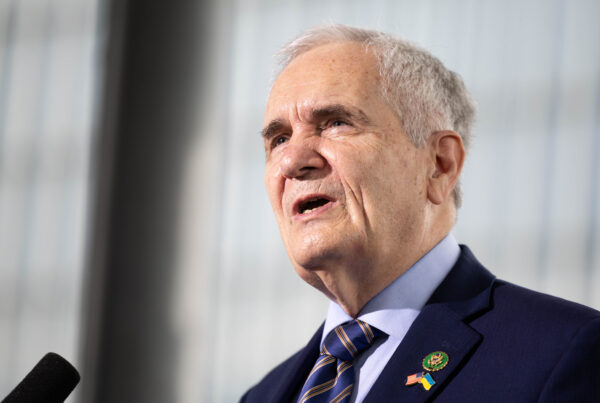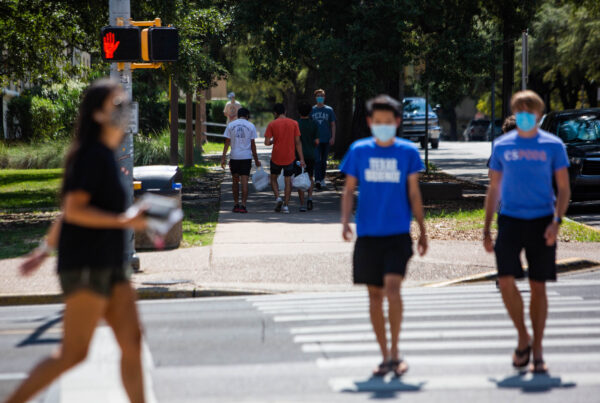For the last few years, it seems Texas summers have become progressively hotter – each with more record-setting triple-digit days than the year before.
But how is this summer going?
Depending on what part of Texas you’re in, you may have heard more than a few friends note that this year doesn’t seem to be quite the scorcher of recent summers past. But do such perceptions line up with the facts?
Bob Rose has been tracking the numbers. He’s a meteorologist with the Lower Colorado River Authority in Central Texas. Listen to the interview with Rose in the player above or read the transcript below.
This transcript has been edited lightly for clarity.
Texas Standard: Let’s start with Central Texas, where you are. Has it been a cooler summer?
Bob Rose: Actually, it has. Or, put another way, less hot.
But yes, the data does show that this is less hot than where we were last year at this time and in 2022 at this time. And I think most people remember what awful summers those were.
But right now, the data is indicating that if you look at just June 1 through July 15, our temperatures have been averaging about 2 to 3 degrees above normal, which is still significant. I mean, that’s still hot. But last year at this time, we were running about 3 to 4 degrees above normal – so at least one more degree above normal than where we are at the current time.
Also, a lot of people use the number of triple digit days as a barometer of how hot it has been. And right now, so far this year, Austin has recorded 14 100-degree days up through the middle of July. Last year, at this time, we’d had 25 of those.
So does it depend on how we ask the question? Cooler than normal or cooler than recent years, when we’ve had the hottest years on record in recent years?
Yeah, I guess so. You know, because “normal” when we say “normal” is really an average of what was the weather doing between 1991 and 2020. So we’re comparing it to that period there. But partly factored in that was 2011, which was also another brutal summer for our area.
You know, it just seems that we have really seen a lot more hotter summers in recent times that are not getting calculated into that, like ’22 and ’23. So, when you’re comparing it to normal, yeah, it does matter.
But I think, in reality, most people are remembering what happened last summer and summer before that, that they’re kind of comparing it to.
» GET MORE NEWS FROM AROUND THE STATE: Sign up for Texas Standard’s weekly newsletters
How often do we reevaluate “normal” for an area?
Every ten years.
Like, right now we’re using 1991 through 2020. In the early 2030s, we’re going to jump ahead and lose the 90s. And then we’ll start calculating from 2020 forward.
Looking statewide, at Texas as a whole, are there areas that have still been especially plagued by extreme heat?
It’s mainly been the western half of the state.
But I’ll also add that even though it has been unusually hot out there as well – and I’m talking the area from San Angelo out to Midland and Lubbock and those locations – it hasn’t been quite as hot as where we were last year at this time, where, again, much of that area was about 3 to 4 degrees above normal.
Now, they have seen quite a few more triple digit days out in the western half of the state compared to, say, Central Texas or North Texas. But still, this has not been quite as hot of a summer even across West Texas.
Our perceptions of the heat might also be affected by what else is happening with the weather. Has it been wetter than usual?
No. If you look at the data, it has not been wetter than normal. But we have had more periods of rain since the first of the summer. And part of that has been tropical weather.
We’ve had a tropical storm and a hurricane which have affected Texas and much of the state, especially Central and Southern Texas, were affected by Alberto back in June and did get some rain out of that. For Beryl, not quite as much, especially for Central Texas, but East Texas and Houston area definitely felt the effects of Beryl. So that’s been part of it.
But also along with that, we’ve seen a couple of unusual cold fronts come south since the start of summer. And each of these fronts have produced rain across a good part of North and Central Texas and even getting into West Texas as well. We didn’t see that at all last year or the year before.
So this has just been an unusual pattern.
There is still a lot of summer ahead. What’s the outlook?
The outlook is that temperatures will average above normal. You know, that’s kind of a given. It just seems that we’re in a period right now where our summers are warmer.
But I will add to this that one of the reasons why we haven’t seen quite as hot of a summer this year is that the heat dome has been situated more to our west or more to our east through the summer than directly on top of us. Now, last summer, it was just right on top of us through much of the summer.
Interestingly, the forecasts are saying that the heat dome will continue to be situated just to our west – more over, say, New Mexico and southern Colorado and not directly over Texas. At times, it probably will, but I think based on what I’m seeing and what we’ve seen so far this summer, I think that the heat dome is going to stay a little more to our west.
As a result, I don’t think we’re looking at a brutally hot August similar to what we had last year or in ’22. I do think much of Texas is still going to see some more triple-digit days coming up, but I don’t see the real extreme heat like we had last year where, you know, many areas were seeing 108°, 110°, things like that. I don’t think we’re going to be seeing the kind of extreme temperatures similar to last summer, mainly because that heat dome is not going to be directly over the state of Texas.
Is there anything else interesting you found when you examined the numbers?
Well, yes. There was just one thing that I thought I would mention.
One of the factors that has led to this being so warm this summer, and really the last two summers as well, has been our nighttime temperatures. The nighttime temperatures have been unusually warm. And when you look at the departure from what we call “normal,” it has been bigger than the daytime departure from normal.
So, just for an example, I’ll tell you here in Austin, our minimum temperature, if you average them all together through the middle of July, have been the warmest on record. And what year was in number two? It was actually 2022. And then 2023 was actually in the mix as well at number three.
So it just seems our nighttimes are also not cooling off as much as they used to.
If you found the reporting above valuable, please consider making a donation to support it here. Your gift helps pay for everything you find on texasstandard.org and KUT.org. Thanks for donating today.
















